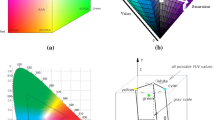Abstract
The existence of large image datasets such as the set of photos on the World Wide Web make it possible to build powerful generic models for low-level image attributes like color using simple histogram learning techniques. We describe the construction of color models for skin and non-skin classes from a dataset of nearly 1 billion labelled pixels. These classes exhibit a surprising degree of separability which we exploit by building a skin pixel detector achieving a detection rate of 80% with 8.5% false positives. We compare the performance of histogram and mixture models in skin detection and find histogram models to be superior in accuracy and computational cost. Using aggregate features computed from the skin pixel detector we build a surprisingly effective detector for naked people. Our results suggest that color can be a more powerful cue for detecting people in unconstrained imagery than was previously suspected. We believe this work is the most comprehensive and detailed exploration of skin color models to date.
Similar content being viewed by others
References
Athitsos, V., Swain, M.J., and Frankel, C. 1997. Distinguishing photographs and graphics on the world wide web. In Proceedings of the IEEE Workshop on Content-Based Access of Image and Video Libraries, San Juan, Puerto Rico, pp. 10–17.
Chen, Q., Wu, H., and Yachida, M. 1995. Face detection by fuzzy pattern matching. In Proc. of Fifth Intl. Conf. on Computer Vision, Cambridge, MA, pp. 591–596.
Cotton, S.D. and Claridge, E. 1996. Do all human skin colors lie on a defined surface within LMS space? Technical Report CSR-96-01, School of Computer Science, Univ. of Birmingham, UK.
Forsyth, D.A. and Fleck, M.M. 1999. Automatic detection of human nudes. International Journal of Computer Vision, 32(1):63–77.
Fukunaga, K. 1972. Introduction to Statistical Pattern Recognition. San Diago, CA: Academic Press.
Gong, Y. and Sakauchi, M. 1995. Detection of regions matching specified chromatic features. Computer Vision and Image Understanding, 61(2):263–269.
Jebara, T.S. and Pentland, A. 1997. Parameterized structure from motion for 3d adaptive feedback tracking of faces. In Proceedings of the IEEE Conference on Computer Vision and Pattern Recognition, San Juan, Puerto Rico, pp. 144–150.
Kjeldsen, R. and Kender, J. 1996. Finding skin in color images. In Proceedings of the International Conference on Automatic Face and Gesture Recognition, Killington, VT, pp. 312–317.
Oren, M., Papageorgiou, C., Sinha, P., Osuna, E., and Poggio, T. 1997. Pedestrian detection using wavelet templates. In Proceedings of the Conference on Computer Vision and Pattern Recognition, San Juan, Puerto Rico, pp. 193–199.
Quinlan, J.R. 1993. C4.5: Programs for Machine Learning, San Mateo, CA: Morgan Kauffman.
Redner, R. and Walker, H. 1994. Mixture densities, maximum like-lihood, and the EM algorithm. SIAM Revew, 26:195–239.
Rowley, H.A., Baluja, S., and Kanade, T. 1998. Neural network-based face detection. IEEE Transactions on Pattern Analysis and Machine Intelligence, 20(1):23–38.
Schiele, B. and Waibel, A. 1995. Gaze tracking based on face-color. In Proceedings of the International Workshop on Automatic Face-and Gesture-Recognition, Zurich, Switzerland, pp. 344–349.
Syeda-Mahmood, T. and Cheng, Y.Q. 1996. Indexing colored surfaces in images. In Proc. of Intl. Conf. on Pattern Recognition, Vienna, Austria.
Van Gemert, M.J.C., Jacques, S.L., Sterenborg, H.J.C.M., and Star, W.M. 1989. Skin optics. IEEE Trans. on Biomedical Engineering, 36(12):1146–1154.
Van Trees, H.L. 1968. Detection, Estimation, and Modulation Theory, vol. I. New York: Wiley.
Wang, J.Z., Li, J., Wiederhold, G., and Firschein, O. 1997. System for screening objectionable images using daubechies wavelets and color histograms. In Proc. of the International Workshop on Interactive Distributed Multimedia Systems and Telecommunication Services, pp. 20–30.
Yang, J., Lu, W., and Waibel, A. 1998. Skin-color modeling and adaptation. In Proceedings of the 3rd Asian Conference on Computer Vision, Hong Kong, China, pp. 687–694.
Author information
Authors and Affiliations
Rights and permissions
About this article
Cite this article
Jones, M.J., Rehg, J.M. Statistical Color Models with Application to Skin Detection. International Journal of Computer Vision 46, 81–96 (2002). https://doi.org/10.1023/A:1013200319198
Issue Date:
DOI: https://doi.org/10.1023/A:1013200319198




